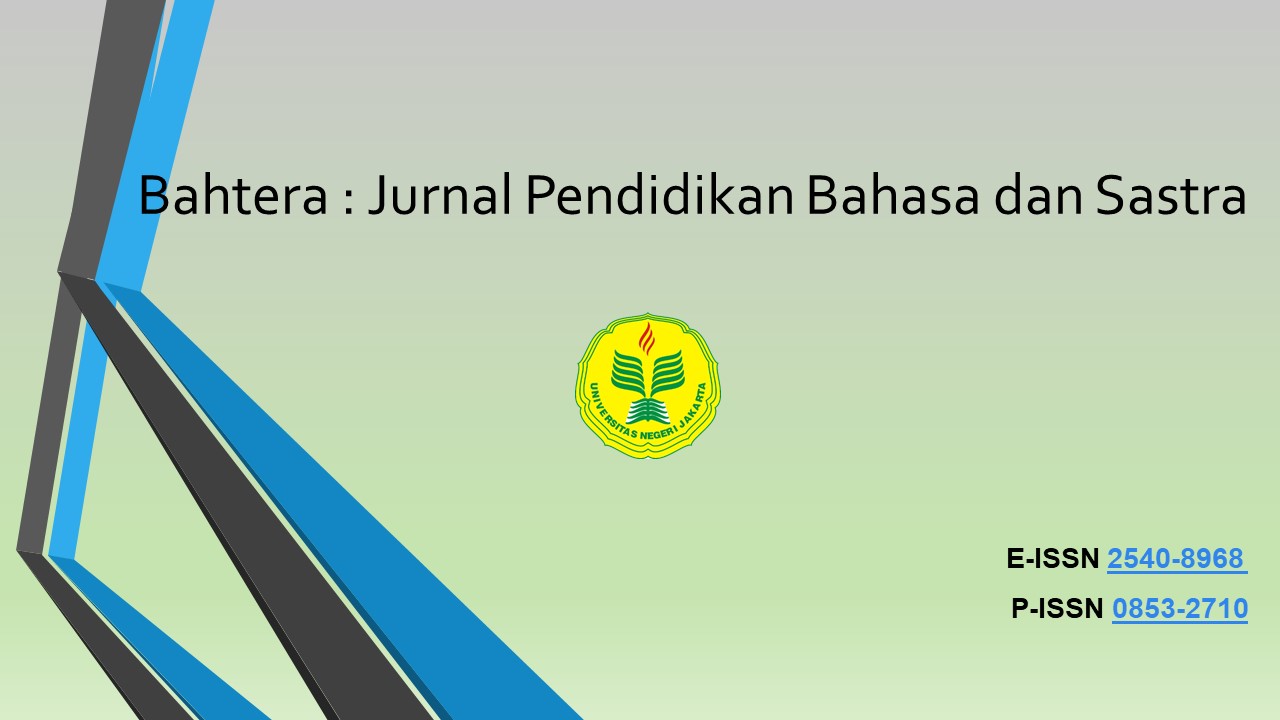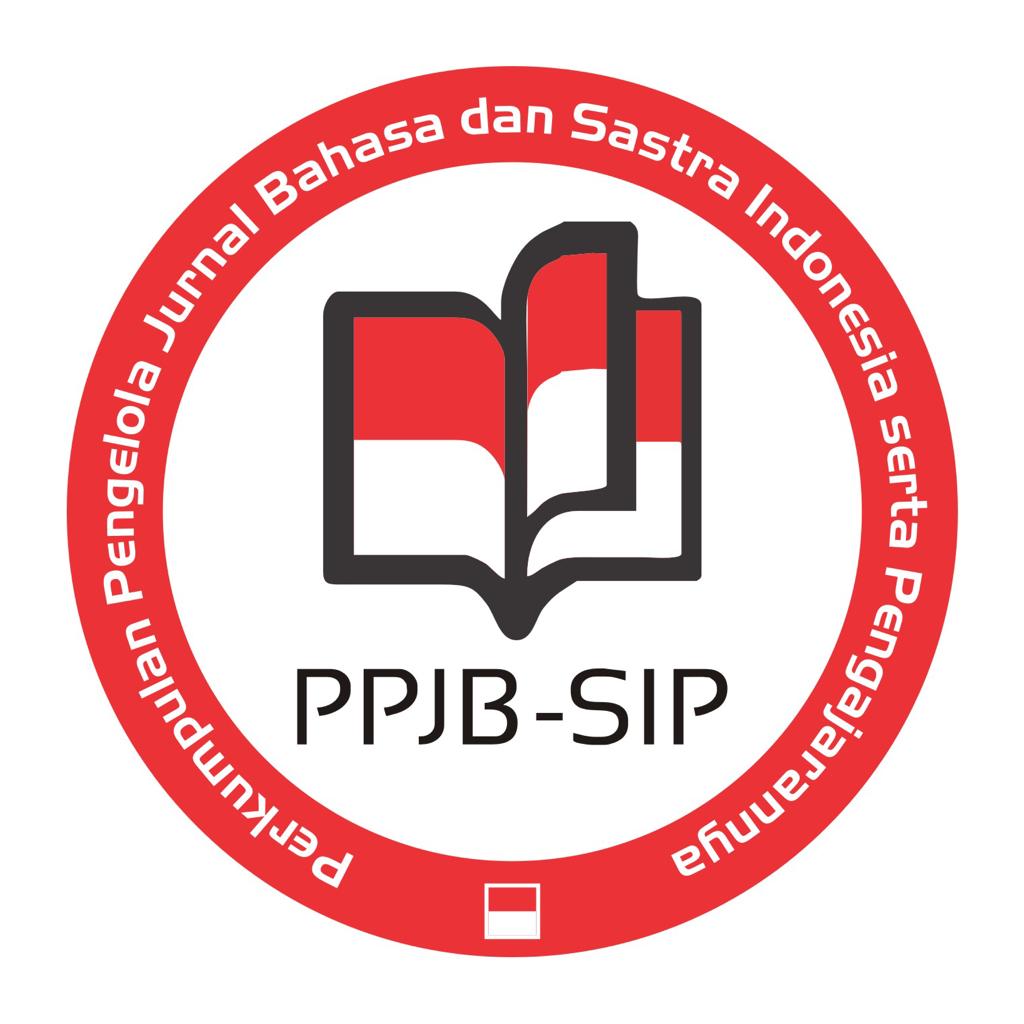STRUKTUR PUISI KERENDAHAN HATI DAN BE THE BEST OF WHATEVER YOU ARE: KAJIAN SASTRA BANDING
DOI:
https://doi.org/10.21009/bahtera.212.07Keywords:
Structural Approach, Poetry, ComparisonAbstract
This research is entitled Structure of Humility Poetry and Be The Best Of Whatever You Are: A Study of Comparative Literature. The purpose of this study is to describe the comparison of the physical structure and inner structure of the poem Humility and Be The Best Of Whatever You Are. This study uses a qualitative descriptive method with data collection techniques documentation on the two poems. The results of the study indicate that there are similarities and differences in the physical structure and inner structure of the two poems. Similarities in physical structure are found in typography, enjabement, rhyme and rhythm, language style, concrete words, and imagery. The similarity of the inner structure is found in the theme, tone, and atmosphere. Meanwhile, the differences in the physical structure are found in the stanzas and lines, punctuation, and diction used. Furthermore, the difference in the inner structure is in the mandate
References
Bakri, F, Permana, H, Fitriani, W, Ambarwulan, D & Muliyati, D 2021, ‘The development of 21st century skills and competence in service teacher through TPACK training workshop’, AIP Conference Proceedings, vol. 2320, no, 1, p. 020032.
Benesty, J et al. 2009, ‘Pearson correlation coefficient’, Noise reduction in speech processing, pp. 1-4.
Bennet, D & Bennet, A 2008, ‘Engaging tacit knowledge in support of organizational learning’, Vine, Emerald Group Publishing Limited, vol. 38, no. 1, pp. 72-94.
Bennett, S & Maton, K 2010, ‘Beyond the “digital natives” debate: Towards a more nuanced understanding of students’ technology experiences’, Journal of Computer Assisted Learning, vol. 26, no. 5, pp. 321-331.
BPS Banten 2021, ‘Persentase penduduk miskin Banten Maret 2021 naik menjadi 6,66 persen’, Available at: https://banten.bps.go.id. (Accessed: 16 July 2021).
Brown, MW & Cudeck, R 1993, ‘Alternative ways of assessing model fit’, Testing structural equation models, vol. 154, no. 4, pp. 136-162.
Chen, PH, Teo, T & Zhou, M 2016, ‘Relationships between digital nativity, value orientation, and motivational interference among college students’, Learning and Individual Differences, vol. 50, no. 3, pp. 49-55.
Curran, PJ, West, SG & Finch, JF 1996, ‘The robustness of test statistics to nonnormality and specification error in confirmatory factor analysis’, Psychological methods American Psychological Association, vol. 1, no.1, p. 16.
Fraenkel, JR, Wallen, NE & Hyun, HH 2012, ‘How to design and evaluate research in education’, New York: McGraw-hill.
Guntara, Y, Hafid, T & Sari, IF 2021, ‘Does TPACK Mastery Affect Teamwork Skills? A Causal-Comparative Study of Pre-Service Physics Teachers’, Jurnal Ilmiah Pendidikan Fisika Al-Biruni, vol. 10, no. 1, pp. 37-47.
Guo, RX, Dobson, T & Petrina, S 2008, ‘Digital natives, digital immigrants: An analysis of age and ICT competency in teacher education’, Journal of educational computing research, vol. 38, no. 3, pp. 235-254.
Hair, JF et al. 2010, ‘Multivariate data analysis: A global perspective: Pearson Upper Saddle River’. New Jersey, vol. 7.
Harris, J, Grandgenett, N & Hofer, M 2010, ‘Testing a TPACK-based technology integration assessment rubric’, Society for Information Technology & Teacher Education International Conference, pp. 3833-3840.
Kasanah, A 2015, ‘Penggunaan Metode Structural Equation Modeling Untuk Analisis Faktor Yang Mempengaruhi Kualitas Pelayanan Perpustakaan Dengan Program Lisrel 8.80’, Universitas Negeri Semarang.
Kirschner, PA & De Bruyckere, P 2017, ‘The myths of the digital native and the multitasker’, Teaching and Teacher Education, vol. 67, no. 3, pp. 135-142.
Kline, T 2005, ‘Psychological testing: A practical approach to design and evaluation’, SAGE Publications.
Mercimek, B, Akbulut, Y, Dönmez, O, Sak, U 2020, ‘Multitasking impairs learning from multimedia across gifted and non-gifted students’, Education Tech Research Dev, vol. 68, pp. 995-1016 .
Messick, S 1998, ‘Test validity: A matter of consequence’, Social Indicators Research, vol. 45, no 1, pp. 35-44.
Minott-Bent, R 2020, ‘Integrating Computer-Facilitated Learning in Urban Schools: Challenges to the Pre-Service Teacher’, Urban Teacher Education and Teaching, pp. 179-194.
Nasution, SH 2018, ‘Pentingnya literasi teknologi bagi mahasiswa calon guru matematika’, Jurnal Kajian Pembelajaran Matematika, vol. 2, no. 1, pp. 14-18.
Nazirwan, N 2019, ‘Peran guru menurut johann heinrich pestalozzi dalam menghadapi digital natives’, Al-Ashlah: Journal of Islamic Studies, vol. 3, no. 2, pp. 1-14.
Oktasari, D, Hediansah, D, Jumadi, J & Warsono, W 2020, ‘Instructional Technology: Teacher’s Initial Perception of TPACK in Physics Learning’, Jurnal Penelitian & Pengembangan Pendidikan Fisika, vol. 6, no. 1, pp. 131-138.
Prensky, M 2001, ‘Digital natives, digital immigrants part 2: Do they really think differently?’, On the horizon, vol. 9, no. 6, pp. 1-6.
Riordan, K 2014, ‘Accuracy, Independence, and Impartiality: How legacy media and digital natives approach standards in the digital age’, England: Reuters Institute for the Study of Journalism.
Saprudin, S, Liliasari, L, Prihatmanto, AS & Setiawan, A 2018, ‘The Design of Media on Two-Lens System Experiment (MTLSE) for Pre-service Physics Teachers’, Jurnal Penelitian & Pengembangan Pendidikan Fisika, vol. 4, no. 2, pp. 91-100.
Teo, T 2013, ‘An initial development and validation of a Digital Natives Assessment Scale (DNAS)’, Computers and Education, vol. l, no. 67, pp. 51-57.
Thang, SM, Nambiar, RMK, Wong, FF et al. 2015, ‘A Clamour for More Technology in Universities: What Does an Investigation into the ICT Use and Learning Styles of Malaysian ‘Digital Natives’ Tell Us?’, Asia-Pacific Edu Res, vol. 24, pp. 353-361.
Tran, T et al. 2020, ‘How digital natives learn and thrive in the digital age: Evidence from an emerging economy’, Sustainability, vol. 12, no. 9, p. 3819.
Utami, IS, Vitasari, M, Langitasari, I, Sugihartono, I & Rahmawati, Y 2020, ‘The Local Wisdom-Based STEM Worksheet to Enhance the Conceptual Understanding of Pre-service Physics Teacher’, Jurnal Penelitian & Pengembangan Pendidikan Fisika, vol. 6, no. 1, pp. 97-104.
Wijanto, SH 2008, ‘Structural Equation Modelling dengan LISREL 8.80: Konsep dan Tutorial’, Yogyakarta: Graha Ilmu.
Wilson, ML, Hall, JA & Mulder, DJ 2020, ‘Assessing digital nativeness in pre-service teachers: Analysis of the Digital Natives Assessment Scale and implications for practice’, Journal of Research on Technology in Education, vol. 8, no. 2, pp. 1-18.
Yong, ST, Gates, P & Harrison, I 2010, ‘Digital native students--where is the evidence’, British Educational Research Journal, vol. 36, no. 3, pp. 503-520.
Downloads
Published
How to Cite
Issue
Section
License
License & Copyright
This work is licensed under a Creative Commons Attribution 4.0 International License.










